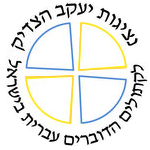Ziv: Parashat Tazria-Metsora
Each week, Gad Barnea or Sister Agnès de la Croix (from the Community of the Beatitudes) proposes a reflection on the portion of the Pentateuch that is read in the synagogue (parashat hashavua). This week the portion is from Leviticus 12:1 - 15:33 with the haftarah (additional reading) from 2 Kings 7:3 - 7:20. They call their reflection “ziv” – a ray of light.
![]() Words that hurt
Words that hurt
Two commentaries wonder, regarding this week’s parasha, whether we have ever seen leprosy of clothes or of houses… and explain that these phenomena are not natural and happen only in the Land of Israel, because it is a land which reveals what is hidden : it adopts holiness and rejects evil. This difficult text of Leviticus indeed deals with hidden things that come to light: the Midrash (Leviticus Rabba 16:1) connects this skin-disease to hidden evil-speaking. Evil-speaking is a real disease and it can be mortal. It spreads stealthily, and locks the victim in a web of paralyzing affirmations from which it is difficult to get free: what is said always leaves traces. The sins committed by the tongue are considered very severe in Rabbinical writings: they are sometimes likened to a murder as in the case where a person is humiliated publicly: he is made to lose face, in Hebrew, he is emptied of his blood… Another commentary wonders: if you pay attention to what goes into your mouth (by observing dietary laws), how much more should you pay attention to what comes out of it… The affections in view here touch upon one’s house, clothes and finally, skin - just like evil-speaking which beings by reaching what is farthest from a person, until it reaches his skin - his very flesh. Moses himself, who has criticized the people, saw himself marked by leprosy at the burning bush (Exodus 4:1).
It is clear that this type of reading does not fully answer the question of the relationship between the disease and the sin neither does it explain the exclusion and reintegration of the leper. The Jewish tradition divides the commandments into “mishpatim” and “hukkim”. The first being easily understood rationally (do not steal, do not kill, because one should love his neighbor), but others are not explained rationally: these are the “hukkim”, for example the restriction on eating certain foods. It is the acceptance and observance of these commandments that becomes itself a source of purity according to the Midrash.
We also find, in the same parasha, the rite of purification of the woman who gave birth (12:2), who needs to observe seven days of purification when she gives birth to a son, like a woman who has her period (15:28). The leper, as well, needs to remain seven days outside his tent (14:8) before his reintegration… These seven days are the days of creation and are a sign of life given - or given-anew after a trial. The woman during her period is not fertile. She has, in a certain sense, lost her life-giving potential. The woman who has given birth has given a new life, by risking her own, and the leper whose white skin testifies of his healing rejoins the society of the living. The questions of purity and impurity are thus tied to life which one needs to constantly choose and celebrate. Shabbat Shalom.
P.S. ... and why is it necessary to be purified for fourteen days if a woman gives birth to a girl? Some say that the circumcision of the male serves as purification, others that the girl, being herself a source of life, adds days to the process….











 Reflecting on Purim and on Lent
Reflecting on Purim and on Lent Rosh HaShana – the Feast of God the Father
Rosh HaShana – the Feast of God the Father Four Words For the Easter Season
Four Words For the Easter Season Ash Wednesday of T. S. Elliot
Ash Wednesday of T. S. Elliot Holy Wednesday
Holy Wednesday Epiphany – the light will conquer the darkness
Epiphany – the light will conquer the darkness